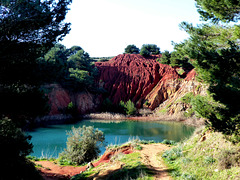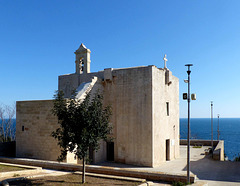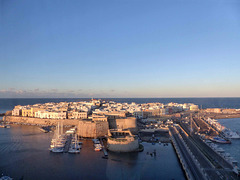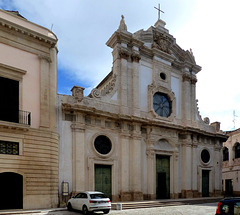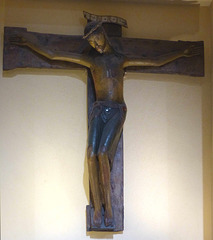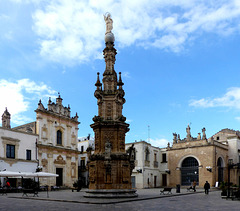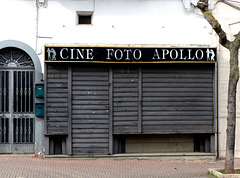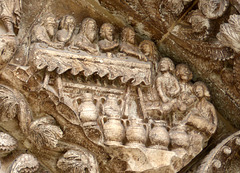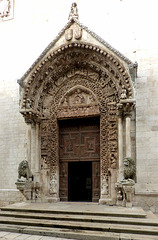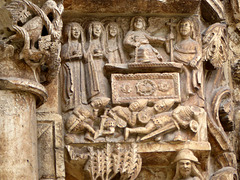
Puglia - Apulia - Apulien
Travelling slowly in Southern Italy.
Roca Vecchia - Torre di maradico
| |
|
|
The settlement of Roca Vecchia was located on a cliff by the sea on the Adriatic coast. It was inhabited since the II millennium BC. Today, the archaeological area of Roca Vecchia extends over thirty hectares and contains important records from different periods of history.
The watchtower that can be seen here is comparatively young. It was built only around 1600.
Otranto - Duomo di Otranto
| |
|
Otranto occupies the site of an ancient Greek city. It gained importance in Roman times, as it was the nearest port to the eastern coast of the Adriatic Sea.
After the end of the Roman Empire, it was in the hands of the Byzantine emperors until it surrendered to the Norman troops of Robert Guiscard in 1068. The Normans fortified the city and built the cathedral, that got consecrated in 1088. When Henry VI., son of Emperor Frederick Barbarossa, married Constanze of Sicily in 1186 Otranto came under the rule of the Hohenstaufen and later in the hands of Ferdinand I of Aragón, King of Naples.
Between 1480 and 1481 the "Ottoman invasion" took place here. Troops of the Ottoman Empire invaded and laid siege to the city and its citadel. Legends tell that more than 800 inhabitants were beheaded after the city was captured. The "Martyrs of Otranto" are still celebrated in Italy, their skulls are on display in the cathedral. A year later the Ottoman garrison surrendered the city following a siege by Christian forces and the intervention of Papal forces.
Otranto had been one of the last Byzantine strongholds in Apulia, but finally, Robert Guiscard could take it. It had probably been such a stronghold, as Otranto had hosted an autocephalous bishopric, only dependent on the patriarchal see of Byzantium since 968. So (Roman) Catholicism had to perform something "convincing" for the so-long (Byzantine) Orthodox Christians. One was to erect a huge church. The Otranto Cathedral, seen in the center, was erected over the ruins of a Paleochristian church from 1080 on and was consecrated in 1088. It is 54 meters long by 25 meters wide and is built on 42 monolithic granite and marble columns.
I had returned to Otranto to see the unbelievable, breathtaking mosaic again. It was created by a monk named Pantaleon and his workshop between 1163 and 1165. Pantaleon lived at the monastery San Nicola di Casole, located a few kilometers south of Otranto.
The mosaic covers the nave, both aisles, the apse and the presbytery. This sums up to a total of 1596 m². About 10 000000 (10 million!) "tesserae" were used.
There are scholars, who have counted up to 700 different "stories", that are told here. Though, these "stories" are often disputed, as today's interpretations are mostly very "vague". German historian Carl Arnold Willemsen published the most important book about the mosaic in Italian " L'enigma di Otranto", that since the 1970s is translated into many languages. I followed his theories.
As I have uploaded so many photos taken in Otranto already, I will upload now only a few. If you want to see more click here:
www.ipernity.com/doc/323415/album/1333378
Otranto - Cave di Bauxite
| |
|
|
|
The Cave di Bauxite is located in the wilderness, just a few kilometers south of Otranto.
Bauxite was extracted from this mine until 1976. Then it was to be shut down and filled in. But before the depression created by the open pit mining was leveled again, a small lake had formed.
As I have uploaded so many photos taken in Otranto already, I will upload now only a few. If you want to see more click here:
www.ipernity.com/doc/323415/album/1333378
Tricase - Madonna della Serra
| |
|
|
Madonna della Serra (aka "Santuario Maria Santissima Assunta"). is located on a hill called Serra di Tricase. According to local legend, the Virgin saved two sailors from a very strong storm and so the chapel was built.
The building dates back to the 16th century and is characterized by typical elements of fortified buildings. When it was erected the Salento coast was frequently attacked by Saracens.
Lido Marini - Martin´s Burger Planet
| |
|
|
Probably this colorful planet is bubbling with life in summer. In winter the planet and the neighboring Tiki Bar are closed.
Gallipoli - Centro storico
| |
|
|
|
The name of the town derives from ancient Greek and translates to "beautiful city". The Greek inhabitants sided with Pyrrhus and Taranto (= Tarent) against ancient Rome but after the defeat in 265 BC it became a Roman colony. After the fall of the Roman Empire, it was sacked by the Vandals and the Goths and was under Ostrogothic rule until 538, when it was conquered by the Byzantines. Gallipoli got rebuilt and experienced a period of commercial prosperity. After numerous incursions, the Arabs finally conquered it in 915 and remained here until 945. Reconquered by the Byzantines the first major restructuring and strengthening of the castle went underway.
In 1055 it was unsuccessfully sieged by the army of Roberto il Guiscardo who had to retire defeated in 1056. In 1132, after a year of siege, it was occupied by the Normans. In 1268, it was besieged by Charles I of Anjou´s troops. As many inhabitants were able to flee the city during the siege, the city was repopulated around 1300.
Gallipoli today is divided into two parts, the modern city ("borgo") to the right and the old city ("centro storico") to the left. The old town is located on an island, linked to the mainland by a bridge built in the 16th century.
Early morning
For more photos taken in Apulia click here:
www.ipernity.com/doc/323415/album/1274028
Nardò - Basilica cattedrale di Santa Maria Assunta
| |
|
The Romans conquered Nardò in 269 BC and built the Via Traiana through it. After the fall of the Western Empire and following the battles between Byzantines and Goths, it was absorbed into the Byzantine Empire and, for a brief period, was annexed to the Lombard Kingdom. Between 901 and 924 Nardò was attacked and sacked by Saracens from Sicily. In 1055 the Normans conquered the town and the Benedictine monks were allowed to settle. The second half of the 13th century was followed by Angevin rule, which determined the birth and spread of feudalism.
An early Christian/Byzantine was the predecessor church when under Norman rule, the church was built in 1088. The building suffered from frequent earthquakes. So some arches inside were rebuilt in Gothic style and the floor was raised by 40 centimeters. In the second half of the 13th century, the church tower was built, which in the 14th century, was incorporated to enlarge the church, which also received a new facade.
In the middle of the 15th century, after earthquakes, renewed stabilization measures had to be carried out on the columns and arches. At the beginning of the 18th century, an extensive baroqueization took place with a new facade, main altar and renovation of the side chapels. In 1743 the town of Nardò was again severely damaged by an earthquake. The church tower, rebuilt afterward, fell into the left nave after a lightning strike in 1815.
From 1892 to 1899, during necessary restorations, the baroque stucco was removed.
Nardò - Basilica cattedrale di Santa Maria Assunta
| |
|
The Romans conquered Nardò in 269 BC and built the Via Traiana through it. After the fall of the Western Empire and following the battles between Byzantines and Goths, it was absorbed into the Byzantine Empire and, for a brief period, was annexed to the Lombard Kingdom. Between 901 and 924 Nardò was attacked and sacked by Saracens from Sicily. In 1055 the Normans conquered the town and the Benedictine monks were allowed to settle. The second half of the 13th century was followed by Angevin rule, which determined the birth and spread of feudalism.
An early Christian/Byzantine was the predecessor church when under Norman rule, the church was built in 1088. The building suffered from frequent earthquakes. So some arches inside were rebuilt in Gothic style and the floor was raised by 40 centimeters. In the second half of the 13th century, the church tower was built, which in the 14th century, was incorporated to enlarge the church, which also received a new facade.
In the middle of the 15th century, after earthquakes, renewed stabilization measures had to be carried out on the columns and arches. At the beginning of the 18th century, an extensive baroqueization took place with a new facade, main altar and renovation of the side chapels. In 1743 the town of Nardò was again severely damaged by an earthquake. The church tower, rebuilt afterward, fell into the left nave after a lightning strike in 1815.
From 1892 to 1899, during necessary restorations, the baroque stucco was removed.
The nave
Nardò - Basilica cattedrale di Santa Maria Assunta
| |
|
|
|
The Romans conquered Nardò in 269 BC and built the Via Traiana through it. After the fall of the Western Empire and following the battles between Byzantines and Goths, it was absorbed into the Byzantine Empire and, for a brief period, was annexed to the Lombard Kingdom. Between 901 and 924 Nardò was attacked and sacked by Saracens from Sicily. In 1055 the Normans conquered the town and the Benedictine monks were allowed to settle. The second half of the 13th century was followed by Angevin rule, which determined the birth and spread of feudalism.
An early Christian/Byzantine was the predecessor church when under Norman rule, the church was built in 1088. The building suffered from frequent earthquakes. So some arches inside were rebuilt in Gothic style and the floor was raised by 40 centimeters. In the second half of the 13th century, the church tower was built, which in the 14th century, was incorporated to enlarge the church, which also received a new facade.
In the middle of the 15th century, after earthquakes, renewed stabilization measures had to be carried out on the columns and arches. At the beginning of the 18th century, an extensive baroqueization took place with a new facade, main altar and renovation of the side chapels. In 1743 the town of Nardò was again severely damaged by an earthquake. The church tower, rebuilt afterward, fell into the left nave after a lightning strike in 1815.
The crucifix is called "Cristo Nero" and probably dates from the 13th/14th century. However, according to legend, it dates back to Nardò's Byzantine period. It is said to have been damaged during a Saracen attack and the bleeding of a finger is said to have frightened the Saracens.
Nardò - Guglia dell'Immacolata
| |
|
|
The Romans conquered Nardò in 269 BC and built the Via Traiana through it. After the fall of the Western Empire and following the battles between Byzantines and Goths, it was absorbed into the Byzantine Empire and, for a brief period, was annexed to the Lombard Kingdom. Between 901 and 924 Nardò was attacked and sacked by Saracens from Sicily. In 1055 the Normans conquered the town and the Benedictine monks were allowed to settle. The second half of the 13th century was followed by Angevin rule, which determined the birth and spread of feudalism.
The "Guglia dell'Immacolata" (Tower of the Immaculate Conception) is located in Piazza Salandra in the center of the old town. The baroque tower (19 m high) was built after the devasting earthquake of 1743. In the background you can see the baroque facade of Chiesa San Trifone .
Ginosa - Cine Foto Apollo
Altamura - Cattedrale di Santa Maria Assunta
| |
|
|
The area around the modern Altamura (pop 70.000) was inhabited in early times. There are Bronze Age tumuli and between the 6th and the 3rd century BC, a massive line of megalithic walls was erected. This (later Roman) city was inhabited until the 10th century when it was reportedly looted by Saracens. A couple of centuries after Altamura was reportedly looted by the Saracens, it started to be inhabited again as Emperor Frederick II refounded the city (1232) and ordered the construction of the large Altamura Cathedral, which became one of the most venerated sanctuaries in Apulia.
Altamura was ruled by various feudal families, including the Orsini del Balzo and the Farnese (1538–1734), the latter responsible for the construction of numerous palaces and churches. In the past, Altamura also had a large castle, whose construction dated back to the 11th-13th century, which has been completely demolished.
Altamura Cathedral (Cattedrale di Santa Maria Assunta) is probably the only church that was ever founded by Frederick II. In 1248, under pressure from Frederick, Pope Innocent IV declared Altamura exempt from the jurisdiction of the bishop of Bari, making it a "palatine church", that is the equivalent of a palace chapel. After heavy damage caused by an earthquake in 1316, it was renovated by Robert of Anjou.
Major changes were made to the cathedral in 1534, including switching the front and back around! The cathedral's main facade originally faced west but it now faces east.
The (breathtaking) attraction of Altamura Cathedral is its main portal, which has been dated to the 14th and 15th centuries. It is Gothic, but in an unusual local style with Byzantine and strong Romanesque influences. I would even see this as "Romanesque/Gothic". It is remarkable for its wealth of details and a large number of biblical scenes.
Only at the Wedding at Cana, there were so many wine jars
Since I have already uploaded many photos taken here during previous trips, I will only add a few now.
If you want to see more photos from Altamura, click here:
www.ipernity.com/doc/323415/album/1334214
Altamura - Cattedrale di Santa Maria Assunta
| |
|
The area around the modern Altamura (pop 70.000) was inhabited in early times. There are Bronze Age tumuli and between the 6th and the 3rd century BC, a massive line of megalithic walls was erected. This (later Roman) city was inhabited until the 10th century when it was reportedly looted by Saracens. A couple of centuries after Altamura was reportedly looted by the Saracens, it started to be inhabited again as Emperor Frederick II refounded the city (1232) and ordered the construction of the large Altamura Cathedral, which became one of the most venerated sanctuaries in Apulia.
Altamura was ruled by various feudal families, including the Orsini del Balzo and the Farnese (1538–1734), the latter responsible for the construction of numerous palaces and churches. In the past, Altamura also had a large castle, whose construction dated back to the 11th-13th century, which has been completely demolished.
Altamura Cathedral (Cattedrale di Santa Maria Assunta) is probably the only church that was ever founded by Frederick II. In 1248, under pressure from Frederick, Pope Innocent IV declared Altamura exempt from the jurisdiction of the bishop of Bari, making it a "palatine church", that is the equivalent of a palace chapel. After heavy damage caused by an earthquake in 1316, it was renovated by Robert of Anjou.
Major changes were made to the cathedral in 1534, including switching the front and back around! The cathedral's main facade originally faced west but it now faces east.
The (breathtaking) attraction of Altamura Cathedral is its main portal, which has been dated to the 14th and 15th centuries. It is Gothic, but in an unusual local style with Byzantine and strong Romanesque influences. I would even see this as "Romanesque/Gothic". It is remarkable for its wealth of details and a large number of biblical scenes.
Since I have already uploaded many photos taken here during previous trips, I will only add a few now.
If you want to see more photos from Altamura, click here:
www.ipernity.com/doc/323415/album/1334214
Altamura - Cattedrale di Santa Maria Assunta
| |
|
The area around the modern Altamura (pop 70.000) was inhabited in early times. There are Bronze Age tumuli and between the 6th and the 3rd century BC, a massive line of megalithic walls was erected. This (later Roman) city was inhabited until the 10th century when it was reportedly looted by Saracens. A couple of centuries after Altamura was reportedly looted by the Saracens, it started to be inhabited again as Emperor Frederick II refounded the city (1232) and ordered the construction of the large Altamura Cathedral, which became one of the most venerated sanctuaries in Apulia.
Altamura was ruled by various feudal families, including the Orsini del Balzo and the Farnese (1538–1734), the latter responsible for the construction of numerous palaces and churches. In the past, Altamura also had a large castle, whose construction dated back to the 11th-13th century, which has been completely demolished.
Altamura Cathedral (Cattedrale di Santa Maria Assunta) is probably the only church that was ever founded by Frederick II. In 1248, under pressure from Frederick, Pope Innocent IV declared Altamura exempt from the jurisdiction of the bishop of Bari, making it a "palatine church", that is the equivalent of a palace chapel. After heavy damage caused by an earthquake in 1316, it was renovated by Robert of Anjou.
Major changes were made to the cathedral in 1534, including switching the front and back around! The cathedral's main facade originally faced west but it now faces east.
The (breathtaking) attraction of Altamura Cathedral is its main portal, which has been dated to the 14th and 15th centuries. It is Gothic, but in an unusual local style with Byzantine and strong Romanesque influences. I would even see this as "Romanesque/Gothic". It is remarkable for its wealth of details and a large number of biblical scenes.
The three myrrhbearers reach the empty tomb.
Since I have already uploaded many photos taken here during previous trips, I will only add a few now.
If you would like to see more photos from Altamura, click here:
www.ipernity.com/doc/323415/album/1334214
Altamura - Cattedrale di Santa Maria Assunta
| |
|
The area around the modern Altamura (pop 70.000) was inhabited in early times. There are Bronze Age tumuli and between the 6th and the 3rd century BC, a massive line of megalithic walls was erected. This (later Roman) city was inhabited until the 10th century when it was reportedly looted by Saracens. A couple of centuries after Altamura was reportedly looted by the Saracens, it started to be inhabited again as Emperor Frederick II refounded the city (1232) and ordered the construction of the large Altamura Cathedral, which became one of the most venerated sanctuaries in Apulia.
Altamura was ruled by various feudal families, including the Orsini del Balzo and the Farnese (1538–1734), the latter responsible for the construction of numerous palaces and churches. In the past, Altamura also had a large castle, whose construction dated back to the 11th-13th century, which has been completely demolished.
Altamura Cathedral (Cattedrale di Santa Maria Assunta) is probably the only church that was ever founded by Frederick II. In 1248, under pressure from Frederick, Pope Innocent IV declared Altamura exempt from the jurisdiction of the bishop of Bari, making it a "palatine church", that is the equivalent of a palace chapel. After heavy damage caused by an earthquake in 1316, it was renovated by Robert of Anjou.
Major changes were made to the cathedral in 1534, including switching the front and back around! The cathedral's main facade originally faced west but it now faces east.
The (breathtaking) attraction of Altamura Cathedral is its main portal, which has been dated to the 14th and 15th centuries. It is Gothic, but in an unusual local style with Byzantine and strong Romanesque influences. I would even see this as "Romanesque/Gothic". It is remarkable for its wealth of details and a large number of biblical scenes.
John 20:14-16
Jesus Appears to Mary Magdalene
"At this, she turned around and saw Jesus standing there, but she did not realize that it was Jesus. He asked her, “Woman, why are you crying? Who is it you are looking for?” Thinking he was the gardener, she said, “Sir, if you have carried him away, tell me where you have put him, and I will get him.” Jesus said to her, “Mary.” She turned toward him and cried out in Aramaic, “Rabboni!” (which means “Teacher”).
Since I have already uploaded many photos taken here during previous trips, I will only add a few now.
If you would like to see more photos from Altamura, click here:
www.ipernity.com/doc/323415/album/1334214
Jump to top
RSS feed- Latest items - Subscribe to the latest items added to this album
- ipernity © 2007-2024
- Help & Contact
|
Club news
|
About ipernity
|
History |
ipernity Club & Prices |
Guide of good conduct
Donate | Group guidelines | Privacy policy | Terms of use | Statutes | In memoria -
Facebook
Twitter



